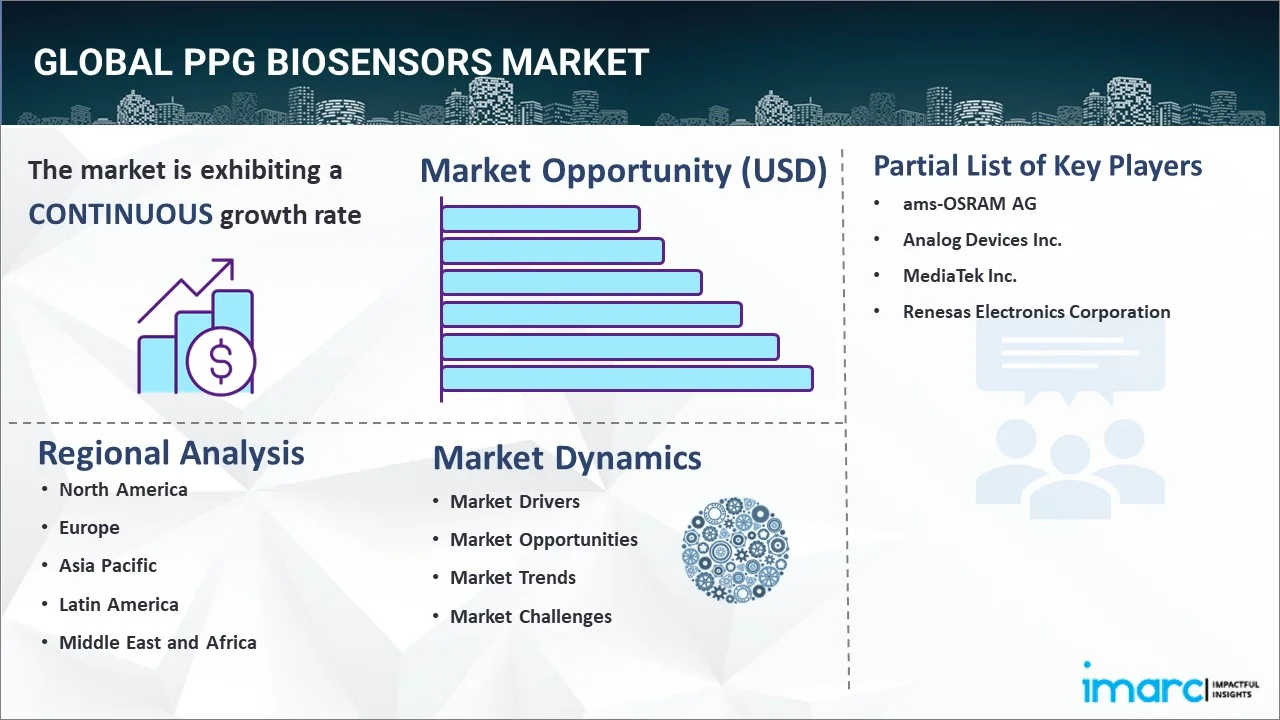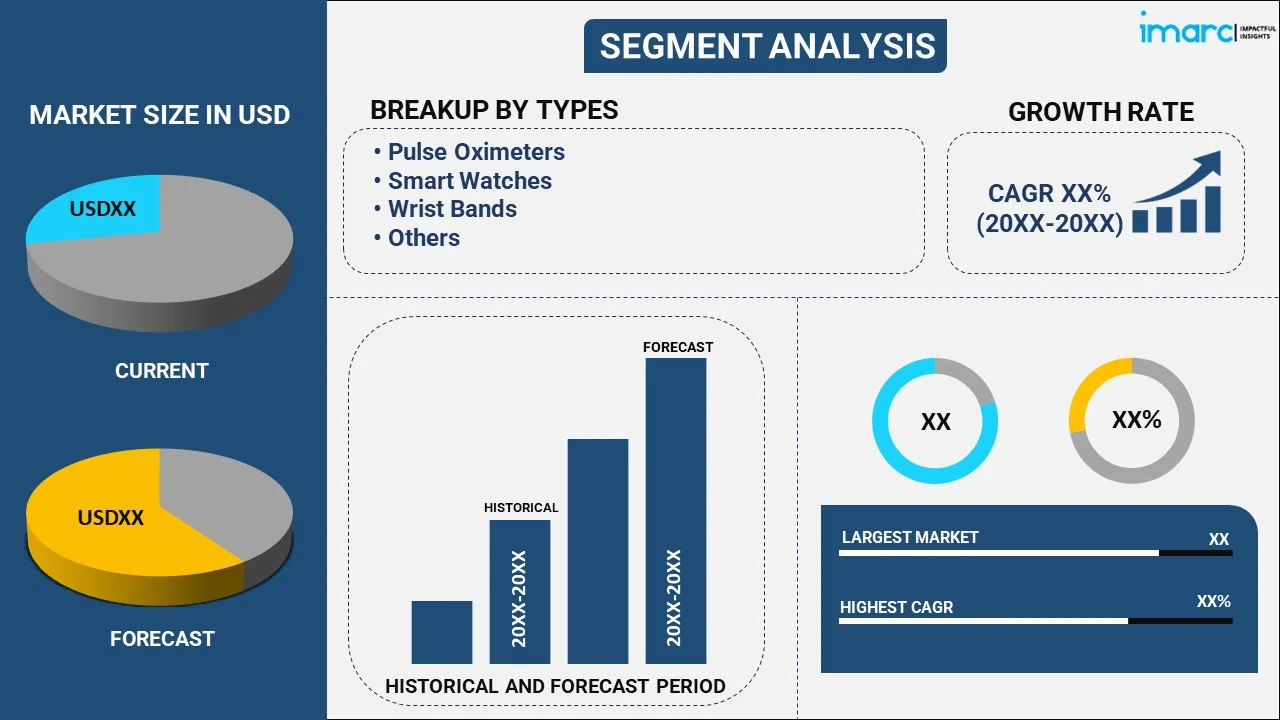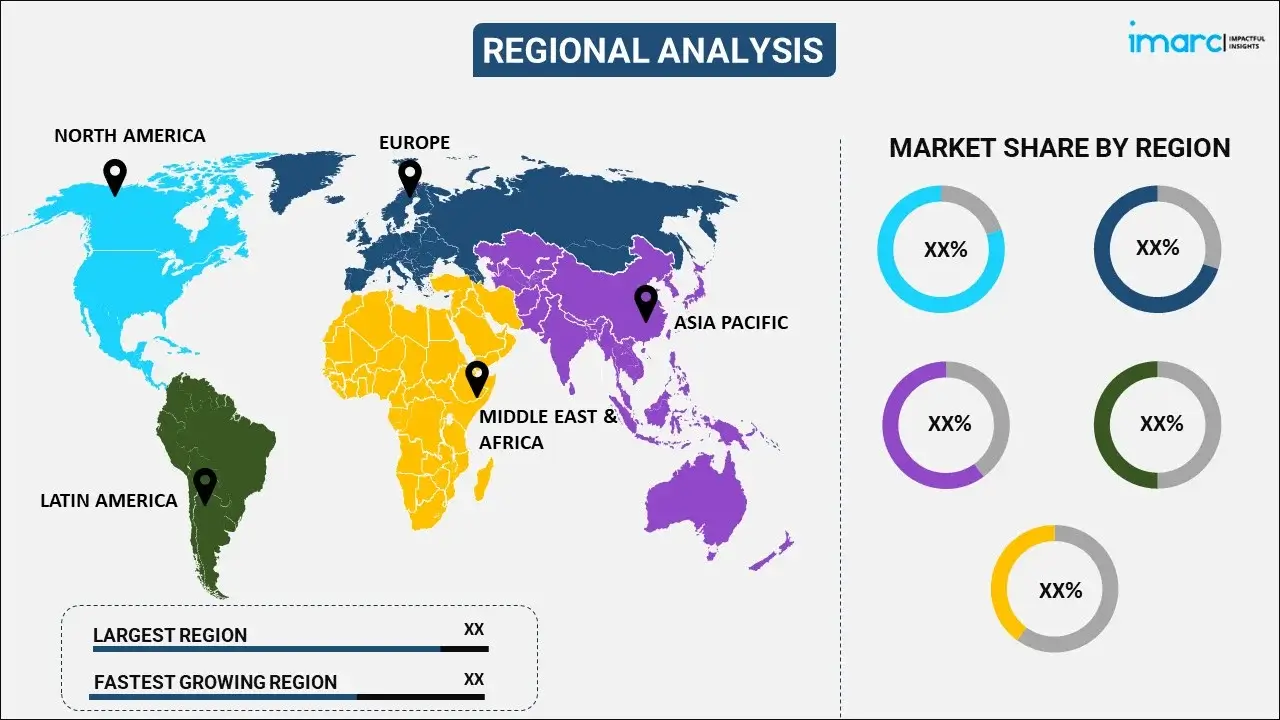
PPG Biosensors Market Report by Type (Pulse Oximeters, Smart Watches, Wrist Bands, and Others), Application (Heart Rate Monitoring, Blood-oxygen Saturation, Blood Pressure, and Others), and Region 2025-2033
Market Overview:
The global PPG biosensors market size reached USD 524.5 Million in 2024. Looking forward, IMARC Group expects the market to reach USD 1,342.5 Million by 2033, exhibiting a growth rate (CAGR) of 10.46% during 2025-2033. The escalating emphasis on personal health and wellness among the masses, the growing interest in wearable technologies and the increasing emphasis on early detection and intervention are some of the major factors propelling the market.
|
Report Attribute
|
Key Statistics
|
|---|---|
|
Base Year
|
2024 |
|
Forecast Years
|
2025-2033
|
|
Historical Years
|
2019-2024
|
| Market Size in 2024 | USD 524.5 Million |
| Market Forecast in 2033 | USD 1,342.5 Million |
| Market Growth Rate (2025-2033) | 10.46% |
Photoplethysmography (PPG) biosensors are non-invasive devices that measure changes in blood volume using light. They work by emitting a light signal, typically near-infrared or green light, onto the skin and then detecting the amount of light that is absorbed or reflected. The variations in observed light intensity are a result of variations in blood volume and flow inside the supporting blood vessels. They are frequently used to monitor other vital indicators as well, including blood pressure, blood oxygen saturation, and heart rate. They have gained significant popularity in wearable devices and healthcare applications due to their simplicity, low cost, and ability to provide real-time physiological data without the need for invasive procedures. They have the potential to revolutionize healthcare by enabling continuous monitoring of vital signs in a non-obtrusive manner, promoting early detection of health issues, and improving overall wellness management.

The escalating emphasis on personal health and wellness majorly drives the global market. This can be supported by the growing interest in wearable technologies that can monitor vital signs and provide real-time health insights. Moreover, there is a shift in the healthcare sector towards preventive and personalized medicine, with an increasing emphasis on early detection and intervention. PPG biosensors provide real-time data on vital signs and can help detect abnormalities or changes in physiological parameters, enabling proactive healthcare management. This preventive approach, coupled with the convenience and ease of use offered by PPG biosensors, is driving their adoption in various healthcare settings. Other factors, including increasing awareness among the masses, continual developments in the healthcare industry and extensive research and development (R&D) activities conducted by key players, are also positively influencing the market.
PPG Biosensors Market Trends/Drivers:
Growing demand for remote patient monitoring
The healthcare industry is experiencing a significant shift towards remote patient monitoring solutions. Additionally, the increasing preference for home-based healthcare and the rising need for continuous monitoring of chronic conditions are driving the demand for PPG biosensors as they offer a non-invasive and convenient method for monitoring vital signs, such as heart rate, blood oxygen saturation, and respiratory rate. In addition, telemedicine has gained significant traction, especially in remote areas and underserved communities. PPG biosensors play a crucial role in telemedicine by providing healthcare professionals with real-time data about patients' vital signs during virtual consultations. This remote monitoring capability helps doctors make accurate diagnoses, adjust treatment plans, and provide timely guidance, leading to improved patient outcomes. The growing adoption of telemedicine globally creates a favorable market environment for PPG biosensors.
Aging population and rising prevalence of chronic diseases
The growing geriatric population is leading to an increased prevalence of age-related health conditions. PPG biosensors offer a cost-effective and non-intrusive method for continuous monitoring of vital signs in elderly individuals, enabling early detection of health issues and reducing hospitalization rates. Also, the ability to monitor patients remotely helps in containing healthcare costs by minimizing the need for frequent hospital visits and enabling proactive care management. Additionally, the increasing prevalence of chronic diseases, such as cardiovascular disorders, diabetes, and respiratory ailments is significantly supporting the market. As a result, the widespread adoption of PPG biosensors as an attractive solution for managing chronic diseases in both healthcare facilities and home-based settings is positively influencing the market.
Continual technological advancements and collaborations
The rapid advancements in wearable technology, including miniaturization of sensors, improved battery life, and wireless connectivity, are catalyzing the demand for PPG biosensors. These technological developments have made it easier to integrate PPG biosensors into various wearable devices, enabling seamless monitoring of vital signs. Additionally, the increasing popularity of smartwatches, fitness bands, and other wearable gadgets are driving the market further. Moreover, various companies and research institutions are actively collaborating to enhance the capabilities of PPG biosensors. Moreover, collaborations between wearable technology manufacturers, healthcare providers, and biosensor developers are driving innovations in the field. These partnerships lead to the development of advanced PPG biosensors with improved accuracy, longer battery life, and enhanced connectivity, thereby creating a positive market outlook.
PPG Biosensors Industry Segmentation:
IMARC Group provides an analysis of the key trends in each segment of the global PPG biosensors market report, along with forecasts at the global, regional, and country levels from 2025-2033. Our report has categorized the market based on type and application.
Breakup by Type:

- Pulse Oximeters
- Smart Watches
- Wrist Bands
- Others
Smart watches dominate the market
The report has provided a detailed breakup and analysis of the market based on the type. This includes pulse oximeters, smart watches, wrist bands, and others. According to the report, smart watches represented the largest segment.
The increasing focus on personal health and fitness is propelling the demand for smart watches with PPG biosensors. These sensors enable users to monitor their heart rate, blood oxygen levels, and overall wellness, promoting a proactive approach to health management. Additionally, the integration of advanced features such as sleep tracking, stress monitoring, and ECG capabilities has further amplified the appeal of smartwatches with PPG biosensors.
On the other hand, the rapid outbreak of COVID-19 virus has further propelled the demand for pulse oximeters as they are essential for monitoring oxygen levels in individuals with respiratory symptoms or those recovering from the virus. The rising geriatric population, with a higher susceptibility to respiratory ailments, is also fueling the demand for pulse oximeters.
Breakup by Application:
- Heart Rate Monitoring
- Blood-oxygen Saturation
- Blood Pressure
- Others
Heart rate monitoring holds the largest share in the market
A detailed breakup and analysis of the market based on the application has also been provided in the report. This includes heart rate monitoring, blood-oxygen saturation, blood pressure, and others. According to the report, heart rate monitoring accounted for the largest market share.
Individuals are increasingly seeking ways to monitor their heart rate in real-time to track their exercise performance, manage stress levels, and maintain overall cardiovascular well-being. Additionally, advancements in PPG technology, including improved accuracy and reliability, enhanced battery life, and the development of compact and comfortable wearables, are contributing to the market.
In addition, the rising awareness among individuals about the importance of maintaining good health and early detection of potential health issues is leading to the adoption of personal health monitoring devices. The integration of PPG biosensors into fitness trackers, smartwatches, and healthcare applications has expanded the consumer base and enhanced the convenience of monitoring blood oxygen levels.
With rising sedentary lifestyles, poor dietary habits, and stress, the incidence of hypertension is on the rise, creating a need for effective and convenient blood pressure monitoring solutions. PPG biosensors offer a non-invasive and user-friendly method for measuring blood pressure, making them highly attractive to individuals seeking continuous monitoring and management of their blood pressure levels.
Breakup by Region:

- North America
- United States
- Canada
- Europe
- Germany
- France
- United Kingdom
- Italy
- Spain
- Others
- Asia Pacific
- China
- Japan
- India
- South Korea
- Australia
- Indonesia
- Others
- Latin America
- Brazil
- Mexico
- Others
- Middle East and Africa
North America exhibits a clear dominance, accounting for the largest the PPG biosensors market share
The report has also provided a comprehensive analysis of all the major regional markets, which include North America (the United States and Canada); Europe (Germany, France, the United Kingdom, Italy, Spain, and others); Asia Pacific (China, Japan, India, South Korea, Australia, Indonesia, and others); Latin America (Brazil, Mexico, and others); and the Middle East and Africa.
The industry in North America is being driven by the growing demand for wearable health monitoring devices, which utilize PPG biosensors to measure vital signs such as heart rate, blood oxygen levels, and respiratory rate. These devices are becoming increasingly popular among consumers as they offer convenience and continuous monitoring capabilities.
Additionally, continual advancements in technology and miniaturization of PPG sensors have improved their accuracy, power efficiency, and comfort, further boosting their adoption. Furthermore, increasing awareness and initiatives to promote personal health and fitness have led to increasing demand for wearable fitness trackers.
On the contrary, Asia Pacific is estimated to expand further in this domain due to the technological advancements in PPG sensor technologies, including miniaturization, improved accuracy, and enhanced connectivity. Additionally, government initiatives and policies promoting digital health and remote patient monitoring are creating a favorable environment for the industry in the Asia Pacific, with a focus on improving healthcare accessibility and reducing healthcare costs.
Competitive Landscape:
The market is experiencing significant growth due to the growing demand for remote patient monitoring and telehealth solutions. Also, leading players are introducing advanced PPG biosensors that enables individuals to monitor their health conditions from the comfort of their homes, eliminating the need for frequent hospital visits, which is creating a positive market outlook. Moreover, numerous companies are developing innovative, user-friendly, and accurate sensor solutions that integrate seamlessly with telehealth platforms. With the increasing emphasis on personal health and fitness, consumers are seeking wearable gadgets that can monitor their physiological parameters during exercise and daily activities, thereby influencing the market. Furthermore, key players in this industry are leveraging this demand by collaborating with fitness technology manufacturers or developing their own line of wearable devices that incorporate PPG biosensors. Moreover, they are also launching specialized biosensors that cater to the unique requirements of the elderly population, such as user-friendly interfaces, long battery life, and seamless data integration with healthcare systems is also contributing to the market.
The report has provided a comprehensive analysis of the competitive landscape in the market. Detailed profiles of all major companies have also been provided. Some of the key players in the market include:
- ams-OSRAM AG
- Analog Devices Inc.
- MediaTek Inc.
- Renesas Electronics Corporation
Recent Developments:
- In 2024, ams-OSRAM launched the next generation vital sign sensor, called the AS7050 Biosignal Sensor Analog Frontend that enables the patients to detect biosignals, such as electrocardiogram (ECG), photoplethysmogram (PPG) and galvanic skin resistance (GSR).
- In 2024, MediaTek Inc. accelerated its sustainability goals by announcing its commitment to net zero emissions by 2050. To achieve this, the company has formulated a systematic blueprint including the deployment of energy saving data centers, installing rooftop solar panels and introducing green power procurement plans.
- In May 2023, Analog Devices Inc. announced an investment of €630 Million in next generation semiconductor R&D and manufacturing facility in Limerick, Ireland. This is expected to augment advances in cutting-edge applications, such as digital biology and robotics. This aligns with the company’s goal of doubling its internal manufacturing capacity to serve customer needs in an efficient manner while expanding its global supply chain.
PPG Biosensors Market Report Scope:
| Report Features | Details |
|---|---|
| Base Year of the Analysis | 2024 |
| Historical Period | 2019-2024 |
| Forecast Period | 2025-2033 |
| Units | Million USD |
| Scope of the Report | Exploration of Historical and Forecast Trends, Industry Catalysts and Challenges, Segment-Wise Historical and Predictive Market Assessment:
|
| Types Covered | Pulse Oximeters, Smart Watches, Wrist Bands, Others |
| Applications Covered | Heart Rate Monitoring, Blood-oxygen Saturation, Blood Pressure, Others |
| Regions Covered | Asia Pacific, Europe, North America, Latin America, Middle East and Africa |
| Countries Covered | United States, Canada, Germany, France, United Kingdom, Italy, Spain, China, Japan, India, South Korea, Australia, Indonesia, Brazil, Mexico |
| Companies Covered | ams-OSRAM AG, Analog Devices Inc., MediaTek Inc., Renesas Electronics Corporation, etc. |
| Customization Scope | 10% Free Customization |
| Post-Sale Analyst Support | 10-12 Weeks |
| Delivery Format | PDF and Excel through Email (We can also provide the editable version of the report in PPT/Word format on special request) |
Key Benefits for Stakeholders:
- IMARC’s report offers a comprehensive quantitative analysis of various market segments, historical and current market trends, market forecasts, and dynamics of the PPG biosensors market from 2019-2033.
- The research study provides the latest information on the market drivers, challenges, and opportunities in the global PPG biosensors market.
- The study maps the leading, as well as the fastest-growing, regional markets. It further enables stakeholders to identify the key country-level markets within each region.
- Porter's five forces analysis assist stakeholders in assessing the impact of new entrants, competitive rivalry, supplier power, buyer power, and the threat of substitution. It helps stakeholders to analyze the level of competition within the PPG biosensors industry and its attractiveness.
- Competitive landscape allows stakeholders to understand their competitive environment and provides an insight into the current positions of key players in the market.
Key Questions Answered in This Report
The PPG biosensors market was valued at USD 524.5 Million in 2024.
The PPG biosensors market is projected to exhibit a CAGR of 10.46% during 2025-2033, reaching a value of USD 1,342.5 Million by 2033.
Key factors driving the PPG biosensors market include growing demand for non-invasive health monitoring, rise in wearable technology, increasing prevalence of cardiovascular conditions, and advancements in signal processing and sensor miniaturization. Consumer interest in fitness tracking and remote diagnostics further fuels adoption across healthcare and consumer electronics.
North America dominated the PPG biosensors market in 2024 due to widespread adoption of wearable devices, strong healthcare infrastructure, high chronic disease rates, and significant investments in digital health and medical technology.
Some of the major players in the PPG biosensors market include ams-OSRAM AG, Analog Devices Inc., MediaTek Inc., Renesas Electronics Corporation, etc.
Need more help?
- Speak to our experienced analysts for insights on the current market scenarios.
- Include additional segments and countries to customize the report as per your requirement.
- Gain an unparalleled competitive advantage in your domain by understanding how to utilize the report and positively impacting your operations and revenue.
- For further assistance, please connect with our analysts.
 Request Customization
Request Customization
 Speak to an Analyst
Speak to an Analyst
 Request Brochure
Request Brochure
 Inquire Before Buying
Inquire Before Buying




.webp)




.webp)












